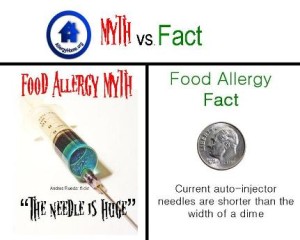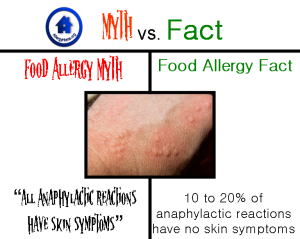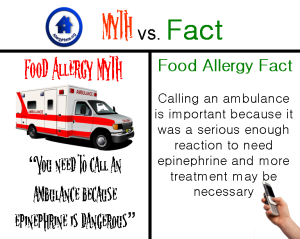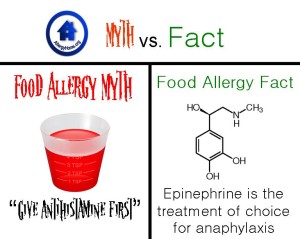Written by Michael Pistiner, MD, MMSc
Anaphylaxis is a severe, life threatening allergic reaction. Epinephrine is the first line treatment of this allergic emergency. Prompt treatment with epinephrine is critical. Here are four food allergy myth pitfalls that can get in the way of the correct treatment. Let’s bust em!
Food Allergy Myth: “The needle is huge”
Fact: The needle is shorter than the width of a dime and very thin.
Commentary: If appropriate for your child, and you have the chance, ask them how long they think the needle is. Lots of kids think that it is as long as the device. This common assumption drives home how important it is to teach our children and help them replace uncertainty and fear with facts and empowerment.
FOOD ALLERGY MYTH: “All anaphylactic reactions have skin symptoms.”
Fact: Although skin symptoms occur in most cases of food induced anaphylaxis, 10 to 20% of cases have no skin findings.
Commentary: This is an important fact that anyone responsible for caring for a child with a food allergy or other causes of anaphylaxis, should be aware of. The lack of skin symptoms should not delay treatment of anaphylaxis. Review your emergency care plans with your healthcare provider and know the symptoms of anaphylaxis.
Food Allergy Myth: “You need to call an ambulance because epinephrine is dangerous.”
Fact: All people experiencing anaphylaxis should be taken to the emergency department by ambulance. Epinephrine is short acting and additional epinephrine, as well as additional medical care may be needed.
Commentary: Some people state that they did not want to give epinephrine because they didn’t want to call an ambulance. In these cases they made two mistakes. Going to the emergency department by ambulance instead of car is also important as emergency personnel can give additional care while en route to the hospital.
Food Allergy Myth: “Give antihistamine first.”
Fact: Epinephrine is the first line treatment for anaphylaxis. Antihistamines are slow to act and haven’t been shown to prevent or stop anaphylaxis.
Commentary: Epinephrine is the treatment of choice for anaphylaxis. Delays in the administration of epinephrine are associated with an increased risk of death. Antihistamines do not treat life threatening symptoms; therefore if used then antihistamines CANNOT be allowed to delay the use of epinephrine (NIAID Guidelines for the Diagnosis and Management of Food Allergy in the United States). Discuss whether or not antihistamines are included in your child’s emergency care plan with your healthcare provider.
From AllergyHome’s Food Allergy Myth vs. Fact Facebook Awareness Campaign Feb. 2013
For more on anaphylaxis and epinephrine see:
1) Living Confidently With Food Allergy: A free, easy to use, handbook designed to give parents the tools to keep their children with food allergies safe and happy while addressing their emotional needs. This fact based guide was reviewed by internationally recognized food allergy experts. This American and Canadian collaboration was lead by Anaphylaxis Canada and is available online and in PDF.
2) Anaphylaxis Preparedness Module: This 6 minute slideshow with audio discusses the importance of being prepared to recognize and treat severe allergic reactions.
3) Food Allergy: A Lot is Riding on our Tires: Dr. Pistiner takes on the serious issue of food allergy related deaths and the all-important need for food allergy and anaphylaxis education and advocacy.
(Please note that this is for educational purposes only. The information provided is not intended to be a replacement or substitute for professional medical advice. Any information that you have received from AllergyHome.org should be verified with your licensed health care provider).




When my daughter was small and had been diagnosed with several severe food allergies, my biggest fear was that I would have to give her a shot with her epipen. Then, when I did have to give it to her, I was very nervous, but I did it and we called the ambulance and went. Once the experience was over and I had processed what had happened over the next few weeks, I began to realize that the experience had been a positive one. I no longer dreaded the possibility of giving her a shot and believe that, as long as we have epinephrine handy, she is safe. Desensitizing to the emergency experience is a good thing.